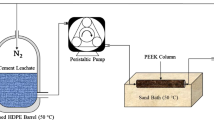Abstract
This study deals with the mineralogical and geochemistry of the Euphrates Formation (Lower Miocene) in Bahr Al-Najaf area in order to assess the lithofacies of the Euphrates Formation for Portland cement manufacturing. Petrographic and mineralogical studies were carried out on 210 core samples, collected from 21 boreholes, and showed that calcite is the dominant mineral with few amounts of quartz, gypsum, feldspar, and a rare amount of dolomite. Clay mineral suites (palygorskite, kaolinite, montmorillonite, and illite) formed about 5% from the total mineral composition. Palygorskite precipitated directly in alkali shallow water rich with Si and Mg ions. Chemical weathering of feldspar under acidic conditions participated in formation of Kaolinite. Geochemistry showed that there is no high variation in chemical constituents with depth, and the average of CaO (51.5), MgO (0.83), SO3 (0.54), SiO2 (4.3), Fe2O3 (0.45), Al2O3 (0.93), L.O.I (40.7), Na2O3 (0.08), K2O (0.14), and Cl- (0.1) qualified the lithofacies of Euphrates Formation to be raw materials suitable for manufacturing the Portland cement. Triangle Block method is applied to estimate the reserve on square area (2 × 2 km2) which is computed to be 63 million tons of medium-tough limestone as potential probable reserve.









Similar content being viewed by others
References
Al-Atia MJ (2001) Evaluation of Mineral Deposits, Practices in Economic Geology. GEOSURV, Iraq, 157P
Al-Bassam KS (2000) The Iraqi Palygorskite: Geology, Mineralogy, Geochemistry, Genesis and Industrial Uses. GEOSURV, Baghdad, 237P
Al-Hashimi HA (1973) The sedimentary facies and depositional environment of the Eocene Dammam and Rus formations, J. Geol. Soc. Iraq; 6:1–18
Al-Hashimi HA, Amer RM (1985) Tertiary Microfacies of Iraq. Geological Survey and Mineral Investigation, Baghdad, 56P
Al-Sayyab A, Al-Ansari N, Al-Rawi D, Al-Jassim JA, Al-Omari F, Al-Sheikh Z (1982) Geology of Iraq. Mosul University Printing, Mosul, Iraq, 277
Barwary AM and Naseira AS (1995) The Geology of Al-Najaf Quadrangle, State Establishment of Geological Survey and Mining (Internal Report) pp 20–23
Buday T (1980) The Regional Geology of Iraq. Stratigraphy and Paleogeography Publication of GEOSURV, Baghdad, 1:445
Cytroky P and Karim S A (1971) Stratigraphy and Paleontology of the Oligocene and Miocene strata near Anah, Euphrates Valley. NIMCO Report No. CZ 140, SOM Library, Baghdad.
Dawood RM (2000) Mineralogy, origin of celestite and the factors controlling its distribution in Tar Al-Najaf, Najaf Plateau. Msc. Thesis, Baghdad University, Iraq.
Dabous AA, Awadalla H, El-Kammer AM, Selim SR (1989) Geochemical specification of some lower tertiary limestones and shales from Upper- Egypt as raw materials for Portland cement industry. Alexandria University, Egypt, pp 313–325
Duda WH (1977) “Cement-Data-Book” International Process Engineering in the Cement Industry, 2nd edn. Bauveriag, GmbH, Wiesbaden and Berlin, 539P
Duda WH (1985) “Cement-Data-Book” International Process Engineering in the Cement Industry, 3rd edn. Bauveriag, GmbH, Wiesbaden and Berlin, 636P
Jassim SZ, Goff JC (eds) (2006) Geology of Iraq. Dolin, Prague and Moravian Museum, Brno, p 341
Kadhim MA (2009) Geochemistry and mineralogy of palygorskite-rich clays in Gercus Formation in Dohuk governorate, north of Iraq. M.Sc. Thesis, University of Baghdad, 115 P.
Kohlhaas B (1983) Cement Engineer’s Handbook 4th English ed. Bauverlag GMBH, Wiesbaden and Berlin, p 800
Lea FM (1970) The Chemistry of Cement and Concrete, 3rd edn. Chemical Publishing Company, Inc., New York, NY, p 727
Rankama K, Sahama TG (1950) Geochemistry Report No. 2496. University of Chicago. Chicago, IL, Baghdad, p 912
Schafer HU (1987) Assessment of raw materials for the industry, reprinted from the journal “World Cement” no.7, pp 273–283, Cement and Concrete Association, London.
Singer A (1989) Palygorskite and Sepiolite Group Minerals. In: Dixon JB, Weed SB (eds) Minerals in soil environment, 2nd edn. Soil Science Society of America, Madison, WI, pp 829–872
Sissakian V-Kh (1999) The Nfayil Formation. GEOSURV Internal Report, Baghdad, Iraq
Soroka I (1979) Portland cement paste and concrete. MacMillan Press Ltd., London, UK p, 338
Author information
Authors and Affiliations
Corresponding author
Rights and permissions
About this article
Cite this article
Al-Dabbas, M., Awadh, S.M. & Zaid, A.A. Mineralogy, geochemistry, and reserve estimation of the Euphrates limestone for Portland cement industry at Al-Najaf area, South Iraq. Arab J Geosci 6, 491–503 (2013). https://doi.org/10.1007/s12517-011-0370-z
Received:
Accepted:
Published:
Issue Date:
DOI: https://doi.org/10.1007/s12517-011-0370-z




